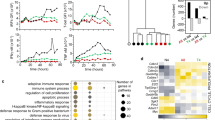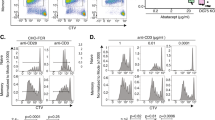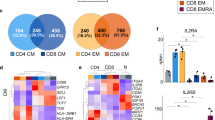Abstract
Regulatory T (Treg) cells require (interleukin-2) IL-2 for their homeostasis by affecting their proliferation, survival and activation. Here we investigated transcriptional and epigenetic changes after acute, periodic and persistent IL-2 receptor (IL-2R) signaling in mouse peripheral Treg cells in vivo using IL-2 or the long-acting IL-2-based biologic mouse IL-2–CD25. We show that initially IL-2R-dependent STAT5 transcription factor-dependent pathways enhanced gene activation, chromatin accessibility and metabolic reprogramming to support Treg cell proliferation. Unexpectedly, at peak proliferation, less accessible chromatin prevailed and was associated with Treg cell contraction. Restimulation of IL-2R signaling after contraction activated signature IL-2-dependent genes and others associated with effector Treg cells, whereas genes associated with signal transduction were downregulated to somewhat temper expansion. Thus, IL-2R-dependent Treg cell homeostasis depends in part on a shift from more accessible chromatin and expansion to less accessible chromatin and contraction. Mouse IL-2–CD25 supported greater expansion and a more extensive transcriptional state than IL-2 in Treg cells, consistent with greater efficacy to control autoimmunity.
This is a preview of subscription content, access via your institution
Access options
Access Nature and 54 other Nature Portfolio journals
Get Nature+, our best-value online-access subscription
$29.99 / 30 days
cancel any time
Subscribe to this journal
Receive 12 print issues and online access
$209.00 per year
only $17.42 per issue
Buy this article
- Purchase on Springer Link
- Instant access to full article PDF
Prices may be subject to local taxes which are calculated during checkout







Similar content being viewed by others
Data availability
Data are deposited in the Gene Expression Omnibus under accession codes GSE163946 (RNA-seq) and GSE162030 (ATAC–seq). Source data are provided with this paper. Other data will be made available upon reasonable request.
References
Buszko, M. & Shevach, E. M. Control of regulatory T cell homeostasis. Curr. Opin. Immunol. 67, 18–26 (2020).
Abbas, A. K., Trotta, E., Simeonov, D. R., Marson, A. & Bluestone, J. A. Revisiting IL-2: biology and therapeutic prospects. Sci. Immunol. 3, eaat1482 (2018).
Sharabi, A. et al. Regulatory T cells in the treatment of disease. Nat. Rev. Drug Discov. 17, 823–844 (2018).
Yu, A., Zhu, L., Altman, N. H. & Malek, T. R. A low interleukin-2 receptor signaling threshold supports the development and homeostasis of T regulatory cells. Immunity 30, 204–217 (2009).
Yu, A. et al. Selective IL-2 responsiveness of regulatory T cells through multiple intrinsic mechanisms supports the use of low-dose IL-2 therapy in type 1 diabetes. Diabetes 64, 2172–2183 (2015).
Donohue, J. H. & Rosenberg, S. A. The fate of interleukin-2 after in vivo administration. J. Immunol. 130, 2203–2208 (1983).
Pol, J. G., Caudana, P., Paillet, J., Piaggio, E. & Kroemer, G. Effects of interleukin-2 in immunostimulation and immunosuppression. J. Exp. Med. 217, e20191247 (2020).
Ward, N. C. et al. IL-2/CD25: a long-acting fusion protein that promotes immune tolerance by selectively targeting the IL-2 receptor on regulatory T cells. J. Immunol. 201, 2579–2592 (2018).
Chorro, L. et al. Interleukin 2 modulates thymic-derived regulatory T cell epigenetic landscape. Nat. Commun. 9, 5368 (2018).
Fontenot, J. D., Rasmussen, J. P., Gavin, M. A. & Rudensky, A. Y. A function for interleukin 2 in Foxp3-expressing regulatory T cells. Nat. Immunol. 6, 1142–1151 (2005).
Toomer, K. H. et al. Essential and non-overlapping IL-2Rα-dependent processes for thymic development and peripheral homeostasis of regulatory T cells. Nat. Commun. 10, 1037 (2019).
Ward, N. C. et al. Persistent IL-2 receptor signaling by IL-2/CD25 fusion protein controls diabetes in NOD mice by multiple mechanismss. Diabetes 69, 2400–2413 (2020).
Grasshoff, H. et al. Low-dose IL-2 therapy in autoimmune and rheumatic diseases. Front. Immunol. 12, 648408 (2021).
Chen, E. Y. et al. Enrichr: interactive and collaborative HTML5 gene list enrichment analysis tool. BMC Bioinformatics 14, 128 (2013).
Gregory, M. A., Qi, Y. & Hann, S. R. Phosphorylation by glycogen synthase kinase-3 controls c-Myc proteolysis and subnuclear localization. J. Biol. Chem. 278, 51606–51612 (2003).
Loftus, R. M. et al. Amino acid-dependent c-Myc expression is essential for NK cell metabolic and functional responses in mice. Nat. Commun. 9, 2341 (2018).
Oh, H. et al. An NF-κB transcription-factor-dependent lineage-specific transcriptional program promotes regulatory T cell identity and function. Immunity 47, 450–465 (2017).
Rovira-Clave, X., Angulo-Ibanez, M., Tournier, C., Reina, M. & Espel, E. Dual role of ERK5 in the regulation of T cell receptor expression at the T cell surface. J. Leukoc. Biol. 99, 143–152 (2016).
Geiman, T. M. & Muegge, K. Lsh, an SNF2/helicase family member, is required for proliferation of mature T lymphocytes. Proc. Natl Acad. Sci. USA 97, 4772–4777 (2000).
Tameni, A. et al. The DNA-helicase HELLS drives ALK− ALCL proliferation by the transcriptional control of a cytokinesis-related program. Cell Death Dis. 12, 130 (2021).
Nevins, J. R. The Rb/E2F pathway and cancer. Hum. Mol. Genet 10, 699–703 (2001).
Saravia, J. et al. Homeostasis and transitional activation of regulatory T cells require c-Myc. Sci. Adv. 6, eaaw6443 (2020).
Rath, S. et al. MitoCarta3.0: an updated mitochondrial proteome now with sub-organelle localization and pathway annotations. Nucleic Acids Res. 49, D1541–D1547 (2021).
Dias, S. et al. Effector regulatory T cell differentiation and immune homeostasis depend on the transcription factor Myb. Immunity 46, 78–91 (2017).
Choy, J. S. et al. DNA methylation increases nucleosome compaction and rigidity. J. Am. Chem. Soc. 132, 1782–1783 (2010).
Lobanenkov, V. V. et al. A novel sequence-specific DNA binding protein which interacts with three regularly spaced direct repeats of the CCCTC-motif in the 5′-flanking sequence of the chicken c-myc gene. Oncogene 5, 1743–1753 (1990).
Nora, E. P. et al. Molecular basis of CTCF binding polarity in genome folding. Nat. Commun. 11, 5612 (2020).
Nagraj, V. P., Magee, N. E. & Sheffield, N. C. LOLAweb: a containerized web server for interactive genomic locus overlap enrichment analysis. Nucleic Acids Res. 46, W194–W199 (2018).
Nasmyth, K. & Haering, C. H. Cohesin: its roles and mechanisms. Annu. Rev. Genet. 43, 525–558 (2009).
Margueron, R. & Reinberg, D. The Polycomb complex PRC2 and its mark in life. Nature 469, 343–349 (2011).
Pasini, D. et al. JARID2 regulates binding of the Polycomb repressive complex 2 to target genes in ES cells. Nature 464, 306–310 (2010).
Assenov, Y. et al. Comprehensive analysis of DNA methylation data with RnBeads. Nat. Methods 11, 1138–1140 (2014).
Parelho, V. et al. Cohesins functionally associate with CTCF on mammalian chromosome arms. Cell 132, 422–433 (2008).
Wendt, K. S. & Peters, J. M. How cohesin and CTCF cooperate in regulating gene expression. Chromosome Res. 17, 201–214 (2009).
Bronner, C., Alhosin, M., Hamiche, A. & Mousli, M. Coordinated dialogue between UHRF1 and DNMT1 to ensure faithful inheritance of methylated DNA patterns. Genes 10, 65 (2019).
Han, M. et al. A role for LSH in facilitating DNA methylation by DNMT1 through enhancing UHRF1 chromatin association. Nucleic Acids Res. 48, 12116–12134 (2020).
Petracovici, A. & Bonasio, R. Distinct PRC2 subunits regulate maintenance and establishment of Polycomb repression during differentiation. Mol. Cell 81, 2625–2639 (2021).
Haring, J. S., Badovinac, V. P. & Harty, J. T. Inflaming the CD8+ T cell response. Immunity 25, 19–29 (2006).
Prlic, M. & Bevan, M. J. Exploring regulatory mechanisms of CD8+ T cell contraction. Proc. Natl Acad. Sci. USA 105, 16689–16694 (2008).
Martin, M. D. & Badovinac, V. P. Antigen-dependent and -independent contributions to primary memory CD8+ T cell activation and protection following infection. Sci. Rep. 5, 18022 (2015).
Sakaguchi, S., Vignali, D. A., Rudensky, A. Y., Niec, R. E. & Waldmann, H. The plasticity and stability of regulatory T cells. Nat. Rev. Immunol. 13, 461–467 (2013).
Geginat, J. et al. Plasticity of human CD4+ T cell subsets. Front. Immunol. 5, 630 (2014).
Wan, Y. Y. & Flavell, R. A. Regulatory T cell functions are subverted and converted owing to attenuated Foxp3 expression. Nature 445, 766–770 (2007).
Dobin, A. et al. STAR: ultrafast universal RNA-seq aligner. Bioinformatics 29, 15–21 (2013).
Liao, Y., Smyth, G. K. & Shi, W. featureCounts: an efficient general purpose program for assigning sequence reads to genomic features. Bioinformatics 30, 923–930 (2014).
Love, M. I., Huber, W. & Anders, S. Moderated estimation of fold change and dispersion for RNA-seq data with DESeq2. Genome Biol. 15, 550 (2014).
Buenrostro, J. D., Wu, B., Chang, H. Y. & Greenleaf, W. J. ATAC–seq: a method for assaying chromatin accessibility genome wide. Curr. Protoc. Mol. Biol. 109, 21.29.1–21.29.9 (2015).
Buenrostro, J. D., Giresi, P. G., Zaba, L. C., Chang, H. Y. & Greenleaf, W. J. Transposition of native chromatin for fast and sensitive epigenomic profiling of open chromatin, DNA-binding proteins and nucleosome position. Nat. Methods 10, 1213–1218 (2013).
Stowers, R. S. et al. Matrix stiffness induces a tumorigenic phenotype in mammary epithelium through changes in chromatin accessibility. Nat. Biomed. Eng. 3, 1009–1019 (2019).
Li, H. & Durbin, R. Fast and accurate short read alignment with Burrows–Wheeler transform. Bioinformatics 25, 1754–1760 (2009).
Zhang, Y. et al. Model-based analysis of ChIP–seq (MACS). Genome Biol. 9, R137 (2008).
Li, Q. H., Brown, J. B., Huang, H. Y. & Bickel, P. J. Measuring reproducibility of high-throughput experiments. Ann. Appl Stat. 5, 1752–1779 (2011).
Lawrence, M. et al. Software for computing and annotating genomic ranges. PLoS Comput. Biol. 9, e1003118 (2013).
Heinz, S. et al. Simple combinations of lineage-determining transcription factors prime cis-regulatory elements required for macrophage and B cell identities. Mol. Cell 38, 576–589 (2010).
Ernst, J. & Kellis, M. ChromHMM: automating chromatin-state discovery and characterization. Nat. Methods 9, 215–216 (2012).
Bhasin, J. M. & Ting, A. H. Goldmine integrates information placing genomic ranges into meaningful biological contexts. Nucleic Acids Res. 44, 5550–5556 (2016).
Oliveros, J. C. Venny. An interactive tool for comparing lists with Venn’s diagrams. https://bioinfogp.cnb.csic.es/tools/venny/index.html (2015).
Kramer, A., Green, J., Pollard, J. Jr. & Tugendreich, S. Causal analysis approaches in ingenuity pathway analysis. Bioinformatics 30, 523–530 (2014).
Mookerjee, S. A., Gerencser, A. A., Nicholls, D. G. & Brand, M. D. Quantifying intracellular rates of glycolytic and oxidative ATP production and consumption using extracellular flux measurements. J. Biol. Chem. 293, 12649–12652 (2018).
Acknowledgements
We thank A. S. Savio for technical assistance. J. Enten, P. Guevara, S. Saigh and N. Ward from the Flow Cytometry Core and M. Brooks, Y. Cardentey and J. Kemper from the Oncogenomics Core of the Sylvester Comprehensive Cancer Center (supported by National Institutes of Health (NIH) P30CA240139); and M. Struthers and F. Ramirez-Valle at Bristol Myers Squibb and A. Villarino at the University of Miami for critically reading the manuscript. This research was supported by funding to T.R.M. from Bristol Myers Squibb and the NIH (R01AI148675).
Author information
Authors and Affiliations
Contributions
Conception and design: A.M. and T.R.M. Acquisition of data: A.M., A. Yu, S.H. and C.M.S. Analysis and interpretation of data: A.M., Z.G., L.W., S.H., Y.B., A. Yan, X.S.C. and T.R.M. Manuscript writing: A.M. and T.R.M. All authors edited and approved the manuscript.
Corresponding author
Ethics declarations
Competing interests
The University of Miami and T.R.M. have patents pending on IL-2–CD25 fusion proteins (WO2016022671A1) and their use (PCT/US20/13152) that have been licensed exclusively to Bristol Myers Squibb, and this research has been supported in part by a collaboration and sponsored research and licensing agreement with Bristol Myers Squibb. The other authors declare no competing interests.
Peer review
Peer review information
Nature Immunology thanks Andrew Wells and the other, anonymous, reviewer(s) for their contribution to the peer review of this work. Jamie D. K. Wilson, in collaboration with the Nature Immunology team.
Additional information
Publisher’s note Springer Nature remains neutral with regard to jurisdictional claims in published maps and institutional affiliations.
Extended data
Extended Data Fig. 1 Sustained pSTAT5 activation of Treg by single injection of mIL-2/CD25 but not of mIL-2One sentence only.
Unfractionated splenocytes from mice (n = 3/group) were injected with mIL-2/CD25, mIL-2 or control PBS and stained with indicated antibodies. (a) Representative flow cytometry plots showing gating for Treg and (b) expression of pSTAT5+ of Tregs at each experimental condition.
Extended Data Fig. 2 Representative FACS gating strategy for sorted Treg at 72 hr post single injection of mIL-2/CD25.
CD4 + T cells from the spleen of CD4 + Foxp3 + -RFP + reporter mice were enriched with anti-CD4 magnetic beads and stained with FITC - anti-CD4 antibody. RFP + Treg were sorted as shown. Treg purity was typically greater than 98%.
Extended Data Fig. 3 Expression of DEGs (FDR < 0.01) at 4 hr after single injection of PBS, mIL2, or mIL2/CD25 using the same RNAseq data set as (Fig. 1d).
Heat map of K-means clustering of 789 differentially expressed genes in response to single injection or re-stimulation with mIL-2/CD25 versus control PBS. Clustering was done using Morpheus software (clustering type: K-means clustering, distance metric: 1-Pearson correlation). The colors in the map display the relative values within indicated experimental conditions. Blue indicates the lowest expression, white indicates intermediate expression, and red indicates the highest expression. Genes were grouped into three clusters on the basis of the expression similarity.
Extended Data Fig. 4 Significant upstream regulators (p value of overlap < 0.05; -2 ≤ z-score ≥ 2) at 1.5 hr post injection of mIL-2/CD25.
The horizontal bars denote the different regulators based on the activation z-score. Red color indicates activation, while blue color indicates inhibition. (b) Top gene network related to ‘Cellular Development, Cellular Growth and Proliferation, Lymphoid Tissue Structure and Development’ in Tregs 1.5 hrs post injection. TCR and STAT5 were identified as key hubs.
Extended Data Fig. 5 Significant modulated canonical pathways predicted by GSEA (a) or Ingenuity Pathway Analysis (IPA) (b) post single injection of mIL-2/CD25.
Cutoffs: GSEA FDR < 0.25; IPA p < 0.05; z-score of activation (orange: active ≥2; blue: inhibited ≤ -2). NES: normalized enrichment score.
Extended Data Fig. 6 Significant modulated upstream regulators predicted by IPA at each time post single administration of mIL-2/CD25.
p < 0.05; z-score of activation (orange: active ≥2; blue: inhibited ≤ -2).
Extended Data Fig. 7 (a) Western blot and (b) normalized (MYC/β-Actin) expression after densitometry analysis (n = 3) showing that MYC protein in Treg was significatively increased at 2 hr and persisted for up to 48 hr post single injection of mIL-2/CD25.
Protein extracts were obtained from FACS-sorted CD4 + Foxp3 + Tregs (>95% Foxp3 + ) isolated from C57BL/6J-Foxp3 + RFP mice at the indicated times after PBS, or mIL-2/CD25 (20 µg) injection. Expression levels of MYC and β-actin were analyzed by Western blotting with anti–MYC (10828-1-AP), or anti-β Actin (20536-1-AP) and revealed with a goat anti-rabbit polyclonal (G-21234). (b) One-way ANOVA with Tukey’s multiple comparisons test, ****p < 0.0001; ***p = 0.0002; n.s p = 0.1131. (c) RNA-seq time course expression of Myc or Slc7a5 in response to mIL-2/CD25. Data shown in (a) is from one representative gel where lanes were spliced to move relevant data neighboring to each other.
Extended Data Fig. 8 Sustained IL-2R signaling reprograms Treg energetic metabolism.
(a) Overlap between DEGs upregulated by mIL-2/CD25 at 72 hr post single injection (FDR < 0.01; fold change ≥ 1.5 X) and a set of mouse mitochondrial genes from the database Mitocarta 3.0. (b) Significant (upregulated, red; down-regulated, green) DEGs in the oxidative phosphorylation (OXPHOS) pathway in response to single injection of mIL-2/CD25 shown as components within each electron transport chain complex.
Extended Data Fig. 9 Enrichment analysis was performed on significantly over-represented genes and ten most significant groups are represented according to GO molecular function.
Reference dotted lines indicate p < 0.05 fold change cutoff.
Supplementary information
Supplementary Table 1
Significant differentially expressed genes from RNA-seq.
Supplementary Table 2
GSEA results.
Supplementary Table 3
Significant differentially accessible regions from ATAC–seq.
Supplementary Table 4
LOLA results.
Source data
Source Data Fig. 1
Statistical source data.
Source Data Fig. 3
Statistical source data.
Source Data Fig. 4
Statistical source data.
Source Data Fig. 5
Statistical source data.
Source Data Fig. 7
Statistical source data.
Source Data Extended Data Fig. 7
Unprocessed western blot.
Source Data Extended Data Fig. 7
Statistical source data.
Rights and permissions
About this article
Cite this article
Moro, A., Gao, Z., Wang, L. et al. Dynamic transcriptional activity and chromatin remodeling of regulatory T cells after varied duration of interleukin-2 receptor signaling. Nat Immunol 23, 802–813 (2022). https://doi.org/10.1038/s41590-022-01179-1
Received:
Accepted:
Published:
Issue Date:
DOI: https://doi.org/10.1038/s41590-022-01179-1
This article is cited by
-
Selective targeting or reprogramming of intra-tumoral Tregs
Medical Oncology (2024)
-
Radiation-induced tumor immune microenvironments and potential targets for combination therapy
Signal Transduction and Targeted Therapy (2023)



